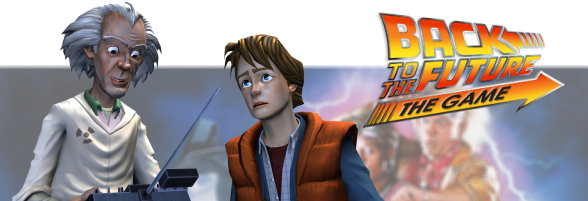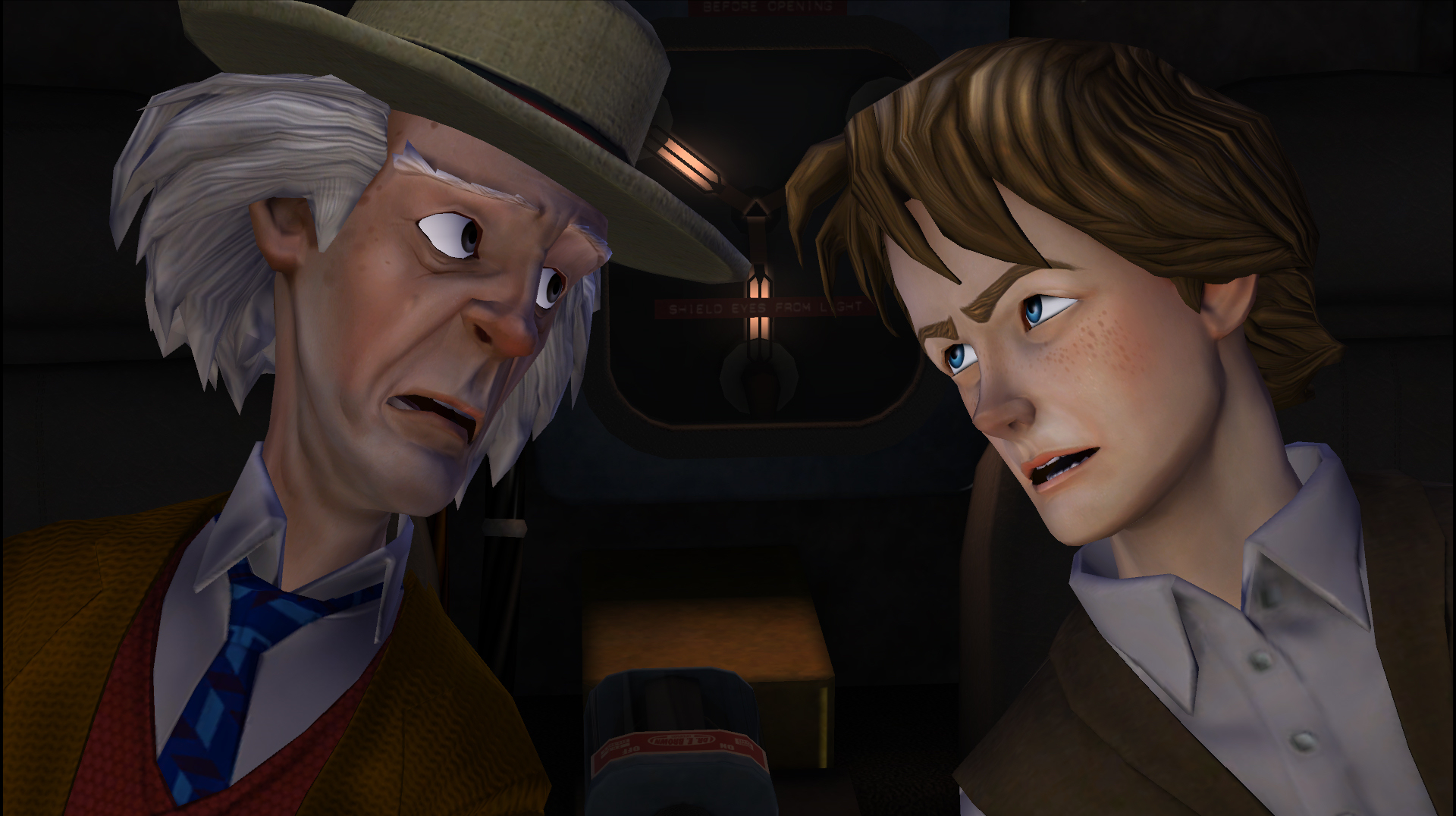Articles

Back to the Future: The Game Episode Two: Get Tannen
The Back to the Future movies were always more about repairing the damage caused by time travel than they were was about taking carefree joyrides into the past and future via the Delorean. In fact, most of the trips through time were at best unintentionally disastrous or at worst intentionally so, like when Biff absconded with the sports almanac in the second movie or prompted the events of what was once the best ride on the Universal tour. It’s appropriate, then, that after a seemingly successful mission in Hill Valley 1931 in the first episode, “Get Tannen” kicks off with Marty and Doc realizing their actions have endangered the life of Marty’s grandfather, and by extension Marty’s very existence. Despite three movies worth of experience that should have conditioned them to know better, they proceed under the hastily corrected delusion that restoring the timeline will be as simple as having Artie McFly skip town to avoid being gunned down by Kid Tannen’s gang on the steps of the iconic courthouse.
Right out the gate, “Get Tannen!” packs a sense of urgency that was lacking in the first episode, which naturally spent a lot of time establishing characters and conflicts, and while this episode presents the heroes with more problems than it resolves for them, setups from the premiere already begin to pay off this month. In accordance with the more frantic plot, many of the puzzles themselves have more immediacy to them, such as when an outnumbered Marty eludes a pummeling by a trio of Tannens in 1986 while attempting to obtain that ever-elusive explanation of “what the hell is going on.” Like the first episode, though, “Get Tannen” takes place primarily in 1931, as there is more time to spend with the multitude of prohibition era Hill Valley residents met in “It’s About Time.”
Nonetheless, two new important characters are introduced in this episode. The first is Officer Parker, the father of Marty’s future girlfriend Jennifer, whose initial appearance supplies the game’s first puzzle and whose destiny is one of many Marty has interfered with. The second is Kid Tannen’s loyal and sweet-natured squeeze Trixie Trotter, a singer at the relocated speakeasy whose respective relationships with Kid and Arthur McFly are leveraged by Marty to try to get Kid arrested, a pivotal event that Marty’s meddlings in the first episode made hash of. This revelation arrives rudely in Marty’s aforementioned confrontation with Biff and some newly acquired siblings in a scene that is heavily reminiscent of the arrival to 1985A in Back to the Future Part II.

Throughout Marty’s struggle to put Kid behind bars, which is the backbone of this episode’s story, clever and entertaining use is made of both the new and reprised characters. I have to say that with the amount of things that seem to be getting set up in a plot that is still unfolding, it’s my impression that Back to the Future: The Game is already a more complicated affair than any of the three movies.
While all the characters have been well-utilized thus far, I can’t help but think that between Kid, Edna Strickland, young Doc, Trixie, Marty’s grandfather and his girlfriend’s father, the size of the main cast is getting a bit unwieldy. It’s too early to turn such suspicions into educated judgment calls though, and that’s the frustration of trying to review a plot-driven game released in parts. The basic plot of Episode 1, for instance, felt to me a bit too much like a slightly redressed version of Back to the Future Part III, but in the context of the larger, still unspooling storyline, rescuing Doc from jail turned out to be more springboard than main narrative thrust. To put it another way, if we convert the percentage of the story seen in Episode 1 to movie runtime, we wouldn’t even be out of 2015 yet in Back to the Future Part II! Retroactively, concerns I have at this stage could very well turn out to be a failure to think fourth dimensionally, and until I see something completely bonkers, it really doesn’t make sense to critically dissect the so-far well done story until it passes the checkered flag.
Repetition amongst the puzzles is problematic, but they are otherwise enjoyable and organically woven into the storyline. Intermediate players and above looking to challenged will be severely disappointed, but it would be pretty disingenuous to act blind sighted by Telltale’s approach at this point. If it wasn’t prior to the release of the first episode, it should be clear by now that Back to the Future: The Game is first and foremost a bid to be the closest thing to a cinematic follow-up to the movies without being a movie itself, and it’s certainly successful in that regard, with a story and performances (though Tom Wilson’s absence remains keenly felt) that will no doubt satisfy fanatics of the film franchise, which is probably everyone in the world but Kroms. The season is already plate-spinning so many character arcs and has tampered with so many individual histories that it is lot of fun to speculate about what’s coming next, and I think anyone already invested in the adventures of Marty and Doc will be engaged by Telltale’s contribution to the franchise.
Where this series continues to be less successful is in getting that final coat of paint finished; the presentation remains plagued with a myriad of minor issues that mar the overall experience. Observe that the transitions between the player-controlled segments and scripted events - from the interactive dialog to the full-blown cutscenes - are rarely smooth, with characters who will, for instance, instantly return to their original seated posture after standing up to talk with you.

This lack of fluidity extends to the actual execution of the cinematics. While Telltale’s choreography continues get better and more ambitious with each project, and it is impressive the way they are blurring the line between cutscenes and gameplay, there is a feeling of awkwardness to some of their more complicated sequences that is difficult to define. While the individual aspects of any given scene - the camerawork, voice acting, and music – are all fine, there’s something perceptibly “off” about the way the elements blend together, as if a looming deadline denied that one last pass needed to perfect the timing or finalize the sound mixing or something. Perhaps I’m mistaking engine limitations for constraints of another persuasion – I won’t pretend to know the prerequisites involved in commanding fine precision of in-game dramatic timing across variable machine specs - but either way, the higher Telltale sets its sights, the more vital it is that their tools don’t hold them back.
The music, which for the most part seems to be cues lifted straight from the movies, sometimes to better effect than others, comes off as a bit lacking when it could have been the memorable flourish that it so often is in a Telltale game. The game knows when it wants to blare Alan Silvestri’s theme, and hearing Huey Louis during the end credits is cool in a “Look what they were able to secure the rights to!” kinda way, but the soundtrack never approaches the righteousness of Sam & Max. Throw in the occasional missing line, some eerie facial expressions to go along with the otherwise excellent animation, and some general glitchiness (was it by design that none of the characters seemed to be able get Marty’s player-selected 30s name consistent?), and you’re left not so much with a glaring, singular problem, but a mottled end result symptomatic of a schedule wound too tight.
I’ve got a final bone to pick that’s more likely to be mine alone. I already weighed in on the story and writing, which I think does justice to the license, but I do have to fault the occasional time when the game’s desire to pay homage the films tips into something else in its frequency. It’s nice to know that the good folks at Telltale are not merely fans but scholars of the films, and as a die-hard I did recognize and appreciate all the various nods, but the self-awareness of Monkey Island or Strong Bad isn’t universally compatible, in my opinion, and the in-jokes that are more distracting than they are subtle or relevant come off as a lack of confidence that the The Game can stand on its own, which is all the more aggravating because it clearly can. Also, am I alone in thinking that it’s getting a bit ridiculous when Marty keeps making “accidental” slip-ups about his origination from another time period for the player’s benefit? It’s like those CSI suspects who keep reprimanding themselves for referring to the deceased in the present tense. It’s a one-time joke mistaken for a recurring one.
Overall, “Get Tannen” continues what is now obvious will be an excellent addition to the long dormant exploits of Marty McFly and Doc Brown. The strength of this series is Telltale’s respect and understanding of the mega-license, and their choice to focus on these games as cinematic experiences serves them well. While my impression is that the gamer reception to the released episodes has been focused on puzzles, I think it’s a slightly overtaxed production modus rather than any creative shortcomings that threatens to make Back to the Future a middling effort in the studio’s output. With games like The Devil’s Playhouse and Tales of Monkey Island under Telltale’s belt, bemoaning that this isn’t the company’s best work is not exactly an insult, but given the caliber of the license and how beautifully it would seem to jive with what Telltale is all about, there’s really no reason why it couldn’t have been.
Review by Jason.